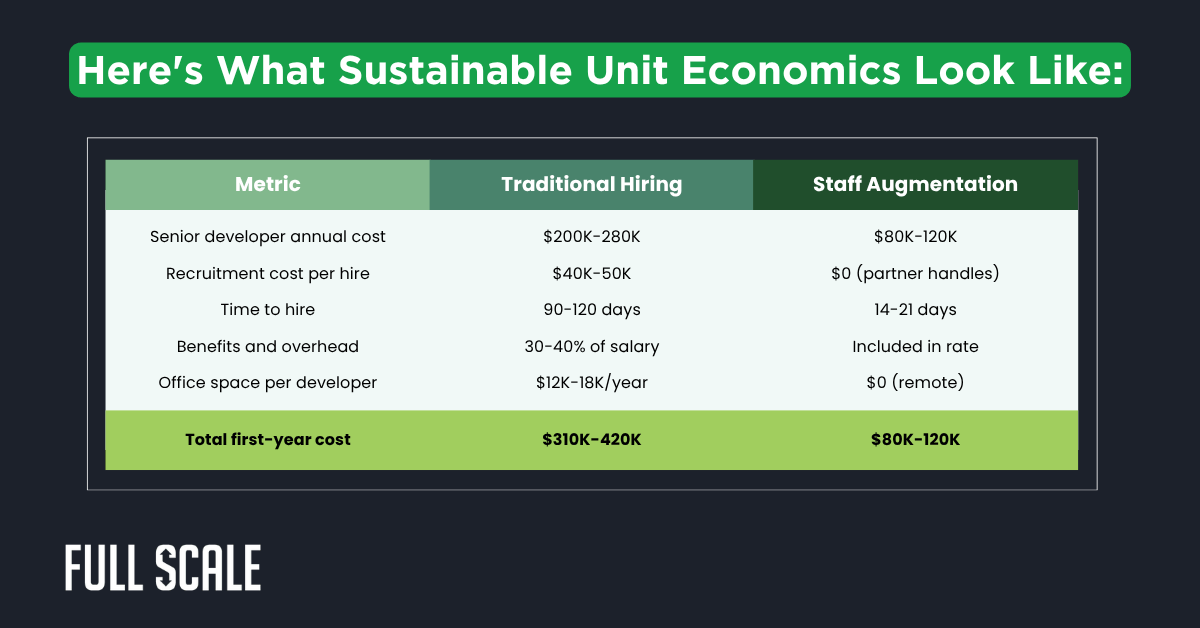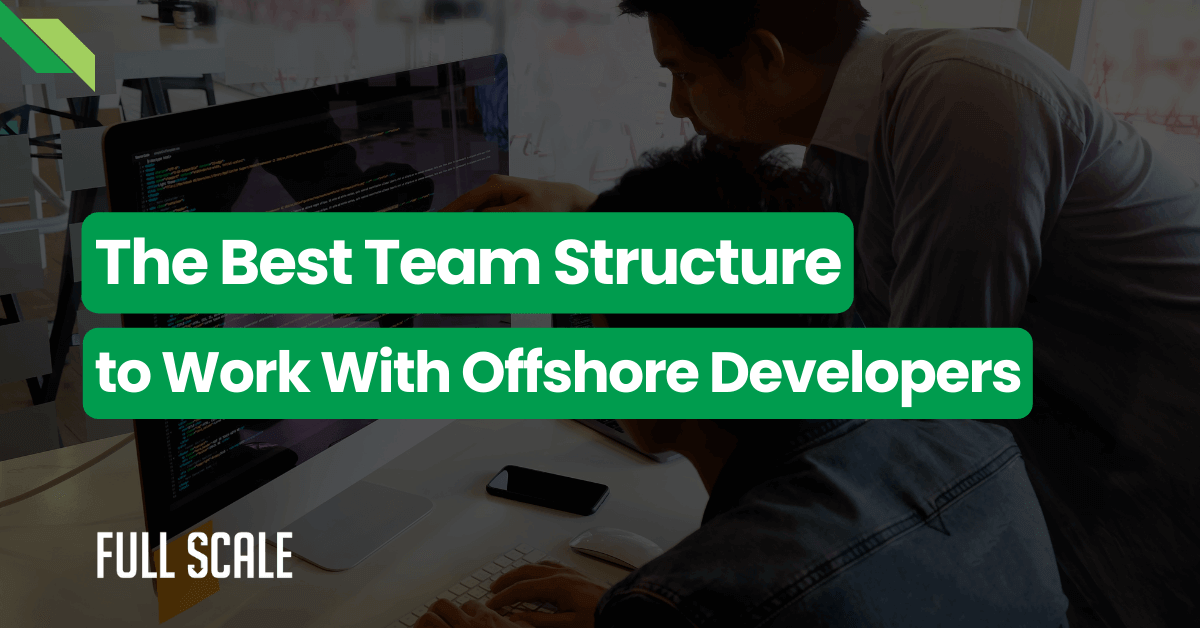Last Updated on 2025-10-15
Here’s the thing most CTOs get backwards about offshore development: they think it’s for companies that are struggling.
Wrong.
The companies that succeed with offshore development are the ones that are growing too fast for their current hiring strategy to keep up.
I just finished a call with a CTO whose company grew 300% last year. Great problem to have, right? Except his engineering team is drowning. His senior developers are spending more time managing than coding. He’s turning down enterprise deals because he doesn’t have the development capacity. His best people are burning out.
Sound familiar?
Most companies wait until they’re in crisis mode to consider offshore development. By then, it’s harder to do it right because you’re making desperate decisions instead of strategic ones.
The smart move? Recognize the signs early, when you still have the luxury of planning and choosing the right partners.
Here are the seven signs that successful companies use to know it’s time to scale globally.
Quick Decision Framework: Is Offshore Development Right for You?
Answer these questions honestly:

3+ Yes: You’re in the ideal position to explore offshore development strategically
1-2 Yes: Monitor these trends closely—you may be approaching the right time
0 Yes: Focus on optimizing your current team structure first
Understanding Key Terms
Before we dive into the signs, let’s clarify what we’re talking about:
- Staff Augmentation: A model where offshore developers work as direct extensions of your in-house team. They’re integrated into your workflows, use your tools, attend your meetings, and report to your managers. They’re team members who happen to work remotely from another country.
- Traditional Outsourcing: A model where an external company handles entire projects with separate project management, often creating communication barriers and hand-off delays. This is what most people think of when they hear “offshore”—and it’s NOT what we’re talking about here.
The difference matters. Staff augmentation gives you control and integration. Traditional outsourcing gives you distance and coordination overhead.
Sign #1: Your Senior Developers Are Spending More Time Managing Than Coding
You hired Sarah because she’s brilliant at architecting complex systems. Now she spends 60% of her time coordinating work between junior developers instead of writing code.
This is what happens when companies try to scale by hiring junior talent to “save money.” Your senior people become full-time mentors and coordinators. It’s an expensive way to not solve your capacity problem.
The real cost? A $200K architect spending three hours daily in meetings isn’t doing $200K worth of architectural work. They’re doing maybe $80K worth of coordination at a $200K price tag. That’s a 60% waste of your most valuable resource.
Let’s break down the actual dollar-per-hour waste:
- Senior architect salary: $200,000/year = $96/hour
- Time spent coordinating vs. architecting: 60% = 24 hours/week
- Weekly waste: 24 hours × $96 = $2,304
- Annual waste per senior developer: $120,000+
Multiply that by every senior developer on your team who’s become an accidental project manager.
Companies that succeed with offshore development use it to free up their senior talent for strategic work. Instead of your architect babysitting junior devs, they’re designing systems while experienced offshore developers handle implementation.
What this looks like in practice: Your senior team focuses on architecture, code reviews, and strategic initiatives. Your offshore team handles feature development, bug fixes, and maintenance. Everyone works at their highest level of contribution.
This isn’t about replacing your senior team. It’s about leveraging them correctly.
Sign #2: Every Job Posting Gets 50+ Applications but Zero Qualified Candidates
You posted a senior React developer role. You get 73 applications in three days.
Five have the right experience. Three respond to your emails. Two show up for interviews. One accepts your offer. Then they get a counteroffer and ghost you.
Three months wasted. Position still open.
Here’s what’s happening: The local market for experienced developers is saturated with companies competing for the same small pool of talent. Everyone’s offering remote work, equity, unlimited PTO, and kombucha on tap.
You’re not actually hiring from a talent pool. You’re hiring from a talent puddle.
According to Stack Overflow’s 2024 Developer Survey, 87% of software developers work outside the United States. That means you’re competing for the remaining 13%—and so is every other tech company in your region.
Meanwhile, you’re ignoring 90% of the world’s software talent because you think “offshore” means “risky.”
The companies winning this game aren’t playing it. They’ve expanded their talent pool globally and are hiring experienced developers who aren’t being courted by 15 other companies simultaneously.
When you have access to developers in regions where demand isn’t artificially inflated, you’re not competing with Google and Meta for the same candidates. You’re accessing talent that’s excited to work on challenging problems without the Bay Area bidding war.
Sign #3: You're Turning Down Projects Due to Development Capacity
Your sales team just landed a $500K deal with an enterprise client. Timeline is aggressive but doable.
Your VP of Engineering says no. Not enough capacity.
The deal dies. Your sales team is furious. Your CEO is wondering why you’re not capitalizing on growth opportunities.
This is the death spiral companies don’t see coming. You have market demand. You have product-market fit. You have customers ready to buy. But you can’t deliver because you’re capacity-constrained by local hiring timelines.
While you’re waiting 90 days to fill that senior full-stack role, your competitor with an offshore team just snatched that enterprise deal. They had developers ready to deploy in two weeks.
The math is brutal:
- Average enterprise deal size: $500K
- Average local hiring timeline: 120 days (4 months)
- Deals lost per quarter due to capacity: 2-3
- Annual revenue impact: $4-6 million in missed opportunities
Every month you delay scaling your team, you’re losing opportunities that may never come back. Markets move fast. Customer needs change. Competitors don’t wait.
Offshore development isn’t about cost savings here. It’s about speed to capacity. When you can scale your team in weeks instead of months, you can say yes to opportunities that would otherwise pass you by.
The companies that win in high-growth markets are the ones that can scale their development capacity as fast as their market opportunity demands.
Sign #4: Your Development Costs Are Growing Faster Than Your Revenue
You grew revenue by 40% last year. Amazing.
Your development costs grew 65%. Less amazing.
Here’s the uncomfortable truth: If your unit economics on software development keep trending in this direction, you don’t have a sustainable business model. You’re just delaying the inevitable math problem.
Salary inflation in tech hubs is brutal. According to Hired’s 2024 State of Software Engineers report, experienced developers in San Francisco and New York are commanding $200K+ base salaries, with total compensation packages reaching $280-350K when including equity and bonuses.
Your costs are growing faster than your ability to generate revenue from the software they’re building.
Most CTOs don’t see this coming because they’re focused on shipping features, not watching the gross margin on development work. Then one day the CFO shows up with a spreadsheet and suddenly everyone’s talking about “efficiency” and “doing more with less.”
The companies that handle this correctly don’t wait until they’re in crisis mode. They look at their development cost structure when things are going well and ask: “Can we maintain this as we scale?”

Offshore development isn’t about cutting corners. It’s about getting the same quality work at a cost structure that allows your business model to scale without sacrificing your margins.
When you can hire experienced developers for 40-60% of US costs without compromising quality, you’re not just saving money. You’re ensuring your unit economics support sustainable growth.
Sign #5: New Hires Take 6+ Months to Become Productive
You finally hired that senior developer after a four-month search. Celebration all around.
Six months later, they’re still ramping up. They’re not bad, just slower to productivity than you expected.
Do the math: Four months to hire plus six months to productivity equals ten months before that $180K investment starts returning value. That’s not a hiring problem. That’s a time-to-value crisis.
The average cost-per-hire for senior developers, when accounting for recruiter fees, interview time, and onboarding resources, is approximately $47,000. Add the salary cost during the ramp period, and you’re looking at $137,000 invested before seeing meaningful output.
The dirty secret about “senior” developers in hot markets? Many of them job-hopped into senior titles without earning the depth of experience the title implies. They’ve got the resume but not always the skills.
You’re paying senior-level salaries for mid-level productivity during a six-month learning curve.
Here’s what companies miss: The best offshore development partners have already solved the onboarding problem. They’ve been placing developers with US companies for years. Their teams know how to integrate into US workflows, use US tooling, and hit the ground running.
When a Full Scale developer joins your team, they’re not learning Jira, Git, and Slack for the first time. They’ve been working in distributed US teams for years. The ramp time isn’t six months. It’s measured in weeks.
The productivity difference is massive. If you can cut time-to-productivity from six months to six weeks, you just changed your development ROI completely.
Productivity Metric | Local Hire | Offshore Partner |
Time to first PR merged | 3-4 weeks | 1-2 weeks |
Time to full productivity | 6+ months | 4-6 weeks |
Familiarity with US workflows | Variable | Pre-trained |
Familiarity with remote tools | Learning | Expert level |
Productive hours in year 1 | 1,200-1,400 | 1,800-1,900 |
Sign #6: You're Delaying Product Features for "Bandwidth"
Your product roadmap looks great on paper. Everything’s prioritized. The market research is done. Customers are asking for these features.
But here’s what actually ships: bug fixes, technical debt cleanup, and maintenance work.
The innovation features? “Q3, maybe Q4 if we have bandwidth.”
This is how market leaders become followers. While you’re maintaining your existing product, your competitor just shipped the feature your customers have been requesting. They’re winning deals because they had the capacity to innovate while you were stuck in maintenance mode.
“Bandwidth” is the corporate euphemism for “we don’t have enough developers and we’re scared to admit it.”
The problem compounds: the longer you delay innovation, the more technical debt accumulates, the more maintenance work piles up, and the less bandwidth you have for strategic features. It’s a vicious cycle.
Research from DORA (DevOps Research and Assessment) shows that high-performing teams spend less than 20% of their time on maintenance and can dedicate 80%+ to new features. Low-performing teams spend 60%+ on maintenance, leaving minimal capacity for innovation.
Successful companies break this cycle by scaling their teams to handle both maintenance and innovation simultaneously. They don’t choose between keeping the lights on and building the future. They do both.
Offshore development gives you the capacity to run two parallel tracks: a team handling operational excellence while another team drives innovation. You’re not robbing Peter to pay Paul anymore.
Sign #7: Your Engineering Team Is Your Biggest Single Point of Failure
You have eight developers. They’re good. They’re committed. They know your codebase inside and out.
And if three of them quit tomorrow, your company is in serious trouble.
This is the risk that keeps CTOs up at night: Your entire business continuity depends on a small group of people concentrated in one location with one compensation structure vulnerable to the same market forces.
When Facebook opens a new office in Austin and starts hiring aggressively, your team gets targeted. When a startup raises a Series B and needs to scale fast, they poach your people. When remote work makes relocation unnecessary, your team has unlimited job options.
You’re running your business on a single point of failure.
The average tech company experiences 13-15% annual turnover, according to LinkedIn’s 2024 Workforce Report. For a team of eight developers, that’s 1-2 departures per year. But turnover doesn’t distribute evenly—you might go two years with stability, then lose three people in one quarter.
What happens then?
- Remaining team gets overloaded
- Product velocity drops 40-60%
- Knowledge gaps create bugs and delays
- Stress causes more people to leave
- Hiring panic leads to bad decisions
The companies that scale successfully don’t put all their eggs in one basket. They build distributed teams across multiple regions. Not because they don’t trust their core team, but because business continuity demands redundancy.
When you have team members across multiple time zones and markets, you’re not vulnerable to local market volatility. You’re not devastated when someone leaves. You’ve built a resilient team structure that can absorb turnover without catastrophic disruption.
Risk Factor | Single-Location Team | Distributed Team |
Vulnerability to local hiring surge | High | Low |
Impact of 2-3 departures | Catastrophic | Manageable |
Knowledge concentration | Dangerous | Distributed |
Salary inflation pressure | Immediate | Buffered |
Business continuity risk | Single point of failure | Redundant systems |
Offshore development isn’t just about adding capacity. It’s about creating strategic resilience in your team structure.
What Technology Leaders Say About Offshore Development Timing
The biggest mistake I see CTOs make is waiting until they're desperate to explore offshore options. The companies that succeed start exploring when they're growing and can plan strategically.
Matt Watson, CEO, Full Scale Tweet
We explored offshore development when we landed our Series A and knew we needed to scale fast. Starting from a position of strength rather than desperation made all the difference in partner selection and integration.
VP of Engineering, FinTech SaaS (3-year Full Scale client) Tweet
I wish I'd done this two years earlier. We thought we needed to 'get everything perfect' first. Turns out, the companies that succeed with offshore are the ones that start exploring it while they have the luxury of planning.
CTO, HealthTech Platform (60+ offshore developers) Tweet
Are You Ready? Here's How to Know
If you’ve recognized yourself in three or more of these signs, you’re not exploring offshore development because you’re desperate. You’re exploring it because you’re growing and you need a scalable solution.
The companies that succeed with offshore development don’t wait until they’re in crisis mode. They evaluate their options while they still have the luxury of strategic planning.
Here’s what readiness actually looks like:
- You have a solid core team that can mentor and integrate new developers
- You have clear processes for onboarding and collaboration
- You’re open to adapting your workflows for distributed team success
- You have leadership buy-in for trying a new approach
- You can commit to proper integration rather than treating offshore as “outsourcing”
The biggest risk isn’t trying offshore development. It’s staying constrained by a hiring strategy that can’t scale with your business while your competitors move faster.
Talk to our team at Full Scale about building a distributed development team that gives you capacity, resilience, and cost efficiency without compromising quality.
Consider offshore when: senior developers manage instead of coding, local hiring takes 4+ months, you turn down projects due to capacity, costs grow faster than revenue, new hires need 6+ months to produce, or your small team is a single point of failure. Best time: during growth, not crisis.
Not necessarily. While you need at least a small core team (typically 3-5 developers minimum) to provide structure and mentorship, company size matters less than growth trajectory. If you’re growing fast and struggling to hire quickly enough, offshore development might be right for you regardless of current headcount. That said, if you’re a solo founder without any developers yet, focus on building your core team locally first.
This is where staff augmentation differs from traditional outsourcing. With the right partner, offshore developers integrate directly into your existing management structure—they attend your standups, use your project management tools, and report to your existing managers. You’re not adding a separate team to manage; you’re extending your existing team. The key is choosing a partner that supports true integration rather than creating an additional management layer.
Great question. Look beyond the marketing claims and evaluate these factors: developer retention rates (95%+ is excellent), client tenure (are companies staying 2+ years?), technical assessment process (do they actually vet developers rigorously?), client references (talk to actual CTOs using them), and trial period options (will they let you test before committing?). If a partner won’t share retention data or connect you with long-term clients, that’s a red flag.
You’re not alone—and you’re not wrong to be skeptical. Most offshore models ARE broken. Traditional outsourcing creates communication barriers, hand-off delays, and quality issues. But staff augmentation is fundamentally different. Instead of treating offshore as a separate vendor, you’re extending your team with developers who work directly with your local team using your processes. The difference between success and failure usually comes down to the integration model, not the offshore concept itself.
With the right partner, you’re looking at 2-3 weeks from decision to developers starting work. The timeline breaks down roughly like this: 1 week for requirements and developer matching, 1 week for interviews and selection, then developers start. Productivity ramps over the first month, but experienced offshore developers typically contribute meaningfully within the first 2 weeks because they’re already familiar with US workflows and remote collaboration tools.
Legitimate concern. This is why choosing the right partner matters. Look for partners that offer US-based contracts ensuring IP ownership stays with you, have robust security protocols (SOC 2 compliance, secure VPNs, data protection policies), and can work within your existing security infrastructure. At Full Scale, for example, we use US-based contracts and our developers work within your security parameters—using your repositories, your access controls, your tools. Your code is always yours.
They might—if you handle it wrong. The key is positioning offshore developers as capacity expansion, not replacement. Make it clear that offshore developers handle work that’s currently not getting done (features in the backlog, technical debt, maintenance) rather than taking work from existing team members. Better yet, frame it as freeing up your senior team for more strategic work. When your team sees offshore developers handling implementation while they focus on architecture and innovation, resistance usually turns to appreciation.
Show them the opportunity cost data. Calculate revenue lost from turned-down projects, delays in shipping customer-requested features, and the competitive disadvantage of slower development velocity. Then compare that to the cost of maintaining your current hiring approach. Frame offshore development as “speed to capacity” rather than “cost savings.” The business case becomes obvious when you show: we can say yes to $2M in opportunities next quarter if we scale our team in 3 weeks vs. the 4 months local hiring takes.
This is a huge advantage of working with the right offshore partner. Unlike hiring locally where you’re stuck with a bad hire for months (recruiting, onboarding, giving them chances, managing out, recruiting again), good offshore partners can replace underperforming developers quickly—often within 1-2 weeks. They have bench talent available and handle the replacement process. This is actually less disruptive than dealing with a bad local hire.
Depends on the region and the developer’s preference. Developers from the Philippines, for example, often have 2-4 hours of overlap with US time zones and are willing to adjust their schedules for key meetings. You don’t need full overlap—even 3-4 hours of overlapping core hours for standups, questions, and collaboration is usually sufficient. Many companies find that some time zone difference is actually beneficial for extended coverage, as long as there’s enough overlap for synchronous communication when needed.
It can be, but most successful companies find it becomes a permanent part of their team structure. What starts as a capacity solution often evolves into a strategic advantage—lower costs, faster scaling, access to specialized skills, and business continuity through geographic distribution. Companies that view offshore as temporary often miss these long-term benefits. The question isn’t “temporary vs. permanent” but rather “what percentage of our team should be distributed vs. local?”
Absolutely—if you approach it correctly. Culture isn’t about physical location; it’s about values, communication styles, and how teams work together. The key is involving offshore developers in your culture from day one: include them in company all-hands, team celebrations, slack channels, and decision-making. Many companies find their offshore developers become some of their strongest culture carriers because they’re intentionally integrated rather than treated as separate contractors. Remote-first culture is a skill, but it’s learnable.

Matt Watson is a serial tech entrepreneur who has started four companies and had a nine-figure exit. He was the founder and CTO of VinSolutions, the #1 CRM software used in today’s automotive industry. He has over twenty years of experience working as a tech CTO and building cutting-edge SaaS solutions.
As the CEO of Full Scale, he has helped over 100 tech companies build their software services and development teams. Full Scale specializes in helping tech companies grow by augmenting their in-house teams with software development talent from the Philippines.
Matt hosts Startup Hustle, a top podcast about entrepreneurship with over 6 million downloads. He has a wealth of knowledge about startups and business from his personal experience and from interviewing hundreds of other entrepreneurs.




